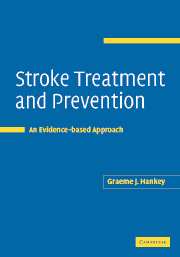Book contents
- Frontmatter
- Contents
- Preface
- 1 The size of the problem of stroke
- 2 Understanding evidence
- 3 Organised acute stroke care
- 4 General supportive acute stroke care
- 5 Reperfusion of ischaemic brain by thrombolysis
- 6 Augmentation of cerebral blood flow: fibrinogen-depleting agents, haemodilution and pentoxifylline
- 7 Neuroprotection
- 8 Treatment of brain oedema
- 9 Anticoagulation
- 10 Antiplatelet therapy
- 11 Carotid artery revascularisation
- 12 Lowering blood pressure
- 13 Lowering blood cholesterol concentrations
- 14 Modification of other vascular risk factors and lifestyle
- 15 Antithrombotic therapy for preventing recurrent cardiogenic embolism
- 16 Arterial dissection and arteritis
- 17 Treatment of intracerebral haemorrhage
- 18 Treatment of subarachnoid haemorrhage
- References
- Index
16 - Arterial dissection and arteritis
Published online by Cambridge University Press: 23 December 2009
- Frontmatter
- Contents
- Preface
- 1 The size of the problem of stroke
- 2 Understanding evidence
- 3 Organised acute stroke care
- 4 General supportive acute stroke care
- 5 Reperfusion of ischaemic brain by thrombolysis
- 6 Augmentation of cerebral blood flow: fibrinogen-depleting agents, haemodilution and pentoxifylline
- 7 Neuroprotection
- 8 Treatment of brain oedema
- 9 Anticoagulation
- 10 Antiplatelet therapy
- 11 Carotid artery revascularisation
- 12 Lowering blood pressure
- 13 Lowering blood cholesterol concentrations
- 14 Modification of other vascular risk factors and lifestyle
- 15 Antithrombotic therapy for preventing recurrent cardiogenic embolism
- 16 Arterial dissection and arteritis
- 17 Treatment of intracerebral haemorrhage
- 18 Treatment of subarachnoid haemorrhage
- References
- Index
Summary
Arterial dissection
Extracranial arterial dissection can occur anywhere in the internal carotid artery (ICA) in the neck, but is unusual at the carotid bifurcation (the most common site for atheroma). In the vertebral artery it tends to affect the distal third. Sometimes carotid and vertebral dissection is a distal extension of aortic dissection.
Intracranial dissection is much rarer than extracranial dissection and more often appears to affect the vertebral and basilar arteries than the ICA and its branches.
Arterial dissection may be caused by trauma and even apparently trivial neck movement (Rothwell et al., 2001).However, it may be spontaneous in patients with hereditary connective tissue disorders, in particular the vascular Ehler–Danlos syndrome (EDS) in which most patients carry mutations in the gene that encodes the pro-α1(III) collagen (Pepin et al., 2000). Other causes include other subtypes of EDS (collagen defects due mostly to mutations in the pro-α1(V) and pro-α2(V) encoding genes), cystic medial necrosis, fibromuscular dysplasia,Marfan's syndrome, and α1 antitrypsin deficiency (Schievink et al., 1998, 2001; Brandt and Grond- Ginsbach, 2002). Hyperhomocystinaemia and recent infection have also been suggested as possible causes (Grau et al., 1999; Gallai et al., 2001; Pezzini et al., 2002).
Following a tear in the intima, blood penetrates the arterial wall to form an intramural haematoma of variable length, and this may expand with time. There may be one or more intimal tears so that the false and true lumens are in communication. Aneurysms sometimes form but seldom become symptomatic (Guillon et al., 1999).
Dissection is the underlying stroke mechanism in about 2.5% of all strokes, and is the second leading cause of stroke in patients younger than 45 years of age.
- Type
- Chapter
- Information
- Stroke Treatment and PreventionAn Evidence-based Approach, pp. 353 - 359Publisher: Cambridge University PressPrint publication year: 2005



